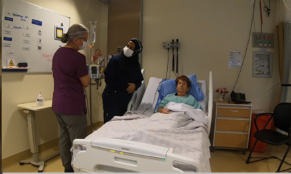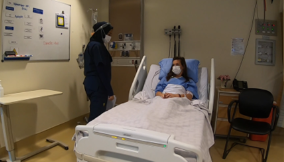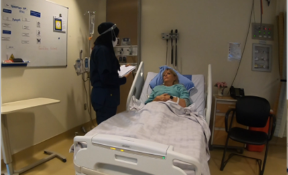| Learning Outcome |
Competency Indicators |
Competent Learner |
Intermediate Learner |
Novice Learner |
| Recognizes
relevant cues
(salient features) that reflects the patient's status to
make a timely
Intervention.
|
- Maintains adequate airway and oxygenation
- Intervenes appropriately to maintain normothermia
- Monitors for cardiac arrhythmias
- Manages BP to maximize cerebral and peripheral perfusion
- Maintains normal fluid & electrolytes
- Prevents complications
|
Consistently
identifies salient
cues to prevent
patient
deterioration
|
With minimal support,
identifies
salient cues to
prevent patient
deterioration
|
With cueing
identifies salient
cues to prevent
patient
deterioration
|
| Likert Scale |
6 5 |
4 3 |
2 1 |
|
| Demonstrates ability to synthesize relevant information to determine
evidence-based priority care needs.
|
- Utilizes relevant data (i.e. ABCs) to create a plan of care
- Identifies key priorities to initiate an intervention in a timely manner (what needs to be done stat, what is safe to leave for the next hour, next shift)
- Determines the intervention which provides the best outcome for the patient
- Identifies clinical deterioration
- Assesses consequences of actions
|
Independently,
identifies and
prioritizes interventions based on
assessment
findings to
optimize health
status.
|
With minimal
support,
identifies
and prioritizes interventions based on assessment
findings to optimize
health status.
|
With significant
support
identifies
and prioritizes interventions based on assessment
findings to optimize
health status.
|
| Likert Scale |
6 5 |
4 3 |
2 1 |
|
| Determine within the context of competing priorities, the ability to assess, plan, implement and evaluate care. |
- Identifies the patient appropriately
- Obtains consent
- Completes a comprehensive assessment
- Interprets results appropriately
- Implements a plan of care
- Evaluates plan of care
|
Independently
identifies and prioritizes interventions
|
With minimal support,
identifies and prioritizes interventions
|
With significant support and prompting,
identifies and prioritizes interventions
|
| Likert Scale |
6 5 |
4 3 |
2 1 |
|
| Demonstrate the
ability to advocate
for patient safety within the context of prioritization.
|
- Identifies potential threats to patient safety
- Advocates for appropriate resources to meet the patient’s needs
- Delegates appropriately
|
Consistently
demonstrates
advocacy to
support patient
safety and quality care
|
With minimal support,
demonstrates
advocacy to
support patient
safety and quality care
|
With significant support and prompting,
demonstrates
advocacy to
support patient
safety and quality care
|
| Likert Scale |
6 5 |
4 3 |
2 1 |
|
| Effectively communicate essential information with the IP team to mobilize resources
|
- Uses SBAR communication
- Provides information in an emergency situation in a succinct manner
- Delegates appropriately
|
Consistently
uses effective communication strategies to advocate for the patient
|
With minimal support,
uses effective communication strategies to advocate for the patient
|
With significant support and prompting,
uses effective communication strategies to advocate for the patient
|
| Likert Scale |
6 5 |
4 3 |
2 1 |
|
.png)



